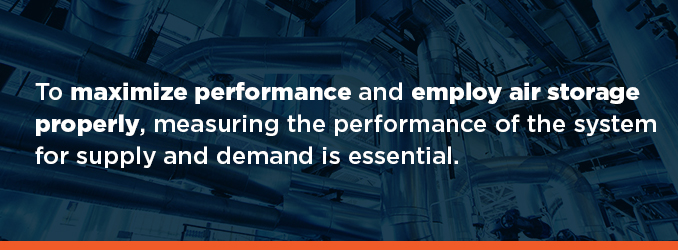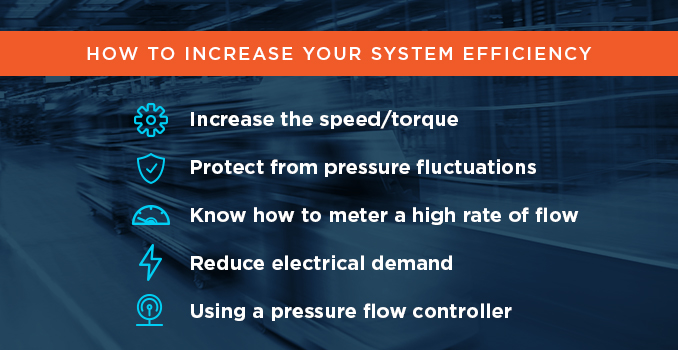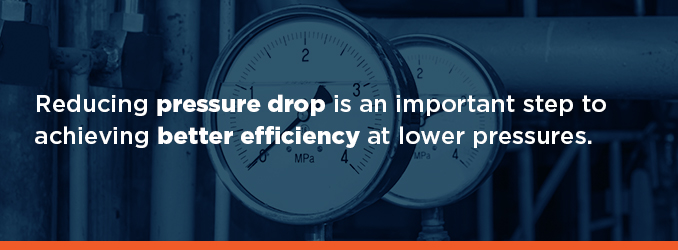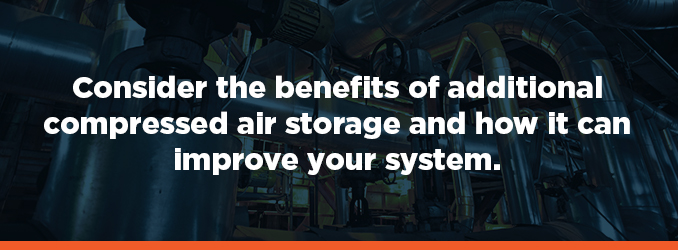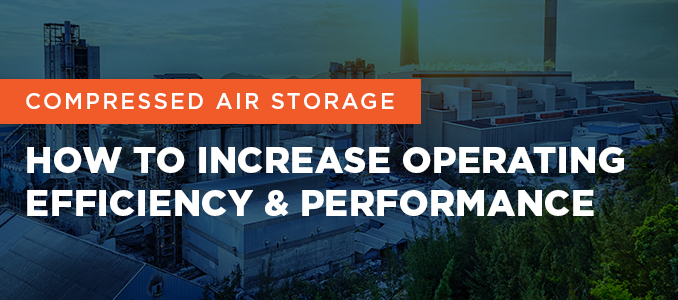
When it comes to increasing the reliability of your equipment and manufacturing efficiency at your plant, compressed air storage is a critical factor that could result in not only extensive savings on energy expenses, but also increased overall operating performance of your compressed air system.
Compressed air systems are vital assets that are utilized in a variety of industries, but because of the high energy demand to generate 1 HP of compressed air power, and the loss of energy in the form of heat, compressed air systems can become more costly than necessary. Ensuring your system is maintained and that your compressed air storage volume is implemented properly can greatly improve your potential to save on energy expenses.
By understanding a few applications for compressed air storage, you can greatly increase your potential to supply large amounts of flow at an increased rate, reduce the demand on your system and make your system pressure more stable. Proper compressed air storage can help you control demand events during peak usage. It can also protect critical operations from other events in the system by turning off the compressor if necessary.
Unfortunately, compressed air storage is often misunderstood — and not implemented properly — which results in little to no increase in efficiency or performance.
Methods and Applications for Compressed Air Storage
For storage, air receivers are often installed in a compressed air system, but to maximize performance and employ air storage properly, measuring both the performance of the system for supply and demand is essential.
Air receivers are designed to store a specific volume of compressed air, which can be utilized when needed. However, adding storage volume without a defined purpose will do little to help you increase the performance or operating efficiency of your system.
Some professionals have said that certain compressors do not need air storage, but overall, the system itself will need to operate at higher pressures with an increased energy demand to maintain peak performance at all times.
Implementation of compressed air storage tanks will always increase the operating efficiency and performance when applied properly. Since system requirements vary, and implementation of storage is dependent on your particular needs, contacting a professional to assess the best application for you will be helpful when installing air receivers or piping into your compressed air system.
System piping, like headers, sub-headers and drop legs, can also be installed into a compressed air system, but they are not as cost effective or as useful as air receivers. In addition, installing piping makes it more difficult to create a significant pressure differential and must rely on a natural pressure drop to do so. A smaller differential will result in less useful storage, but air receivers can help maximize storage with a much higher pressure differential.
By adding compressed air storage, you can improve the speed, or torque, of your system and protect your system from pressure changes, but the size of tank you’ll need is dependent on your compressor’s output and your demand. To estimate compressed air receiver size, you’ll need to multiply the compressor output in cubic feet per minute, or CFM, by standard atmospheric pressure in pressure per square inch absolute, or PSIA, then divide that by the sum of the compressed air pressure and standard atmospheric pressure.
If you have the measurements for your system, you can utilize Quincy’s compressed air storage calculator.
There are a few ways to increase your system efficiency through compressed air storage applications, including by increasing the speed, or torque, of your system, protecting your system from pressure fluctuations, knowing how to use storage to meter a high rate of flow into the system, reducing electrical demand and more considering a pressure flow controller can also stabilize a system.
Contact Us Learn More Find a Dealer Near You
Compressed Air Storage to Increase Speed, Thrust or Torque for Applications
For many applications that operate faster than a regulator can react, the increased demand can cause drops in pressure, which reduces the overall speed the needed amount of air can be delivered. Proper compressed air storage can help increase speed and reduce the demand by supplying an additional volume of air during these types of pneumatic applications.
If a specific pressure is needed to operate properly, especially with actuation speeds less than 1 second, compressed air storage can greatly reduce this demand by controlling pressure drop, allowing more time for the regulator to support the needed flow.
This control of pressure drop will help support repeatability and increase speed, thrust or torque. In addition, you can reduce the pressure fluctuation and header pressure for the system. Without storage, an increase in either starting pressure or the overall system pressure will be needed, which creates higher operating costs and pressure fluctuation.
Compressed Air Storage to Protect From Pressure Fluctuations
As mentioned above, protecting your application from pressure fluctuations through the use of stored compressed air is one advantage of adding additional volume to your system. For some applications that require low pressure, system pressure will often be higher in order to provide and maintain the desired pressure needed for the application.
By increasing the amount of air stored, additional volume can be supplied during the application, reducing the demand on the system and still maintaining the needed pressure through the use of a check valve. This will allow you to reduce pressure drop. Determining the exact size tank for your needed application is important for lower pressure applications — and for increasing efficiency. While having more storage than needed isn’t likely to detract from your system’s overall performance, it still requires more than what is necessary to generate and will increase your energy expenses.
Compressed Air Storage to Meter High Rate of Flow Into the System
Another method for storage to protect the system from pressure fluctuations and to reduce header pressure fluctuations when applications actuate can be achieved by installing a needle valve along with the check valve mentioned above.
By installing an air receiver, you can provide the needed volume air for applications upon actuation in which the needle valve can be adjusted to control the rate of recovery of receiver pressure. This creates a consistent and lower rate of flow into the system. In order to achieve maximum performance, the recovery time needed for receiver pressure must be equal to or greater than the overall actuation time.
Not only will this reduce the horsepower needed for the application, cutting down on energy expenses, but it will also reduce the amount of demand needed for supplying compressed air for specific applications while maintaining maximum performance in the system.
Compressed Air Storage to Support Events in the System Within Allowable Pressure Drop
When differentiating between the storage requirements of compressed air systems and controls, less storage is needed than others depending on the need. Higher load levels and low levels benefit differently from controls and storage. Some professionals have said that certain compressors do not need air storage, but the system overall will benefit from volumes of compressed air storage that can reduce the demand for certain applications.
As air makes its way through the distribution system, pressure drops can occur, and when excessive, can cause an increased demand for energy, and decrease overall system performance. When these drops occur, lower operating pressure may be the result if the drop is upstream. In order to meet the demand, the system will require higher pressures. For the best results, it is important to operate compressed air equipment at the pressure that is at its lowest still efficient. Reducing pressure drops should be conducted before adding more storage capacity, or increasing pressure.
Some pressure decay will occur in the system overall, but adequate storage can allow better control over the system and minimize pressure drop. During system failure, or a compressor failure, extra volumes of air storage can allow for the time needed for the system to auto start. This will maintain system capacity within the allowable pressure drop.
To maintain maximum efficiency, controlling the expansion of air to the lower header pressure can be achieved through a flow controller. Flow controllers help minimize waste while compressors operate at their peak. The pressure differential eliminates unneeded demand and creates useful storage as mentioned above.
The lower the pressure differential, the less useful storage will be achieved. For demand events occurring within the system, the flow controller valve will allow for modulation, displacement and speed, matching the demand and maintaining a fixed pressure.
When you reduce the system’s discharge pressure, you reduce the rate of leakage, increase overall capacity and reduce expenses. However, modifications may be required to pressure regulators, storage sizes, and filters to reduce operating pressure.
Reducing pressure drop is an important step to achieving better efficiency at lower pressures. Lowering pressure levels when operating machinery that utilizes large amounts of compressed air can drastically reduce expenses, and provide a significant annual energy savings for your plant. You may need larger air cylinders to maintain the proper functions of machines working at lower pressure levels. However, the cost for expanding storage size will be a greater investment for saving money on energy expenses.
Compressed Air Storage to Support Large Events and Reduce Energy Demands
For supporting larger system events, or even compressor failures, compressed air storage is one method to reduce the energy demands needed. By supplying extra volume of air during large events, or failures, the amount of horsepower needed will decrease when a flow controller is utilized. Instead of purchasing a second backup compressor, air storage installation can allow the system to start and maintain pressure so it will not need to recover the pressure required for output.
Matching the System’s Supply and Demand Through Compressed Air Storage
The applications for compressed air storage are intended to reduce the system pressure to what is needed and not to exceed horsepower or energy requirements, while maintaining peak performance in your system. For production processes, energy is supplied from air stored at a higher pressure within the piping distribution system. Air compressors replenish that supply being utilized during the application. Achieving a balance between the supply and demands of the air used is what contributes to operation efficiency.
The amount of energy required to compress air equals the energy used in addition to the system’s inefficiencies. Any more or less energy that goes into the system is released from storage. Every time there is a change to either side of the equation, the system rebalances. To achieve the optimum energy level and control the balance, consider that the major sources of energy are the air stored a high pressure in a fixed volume and the reserve rotating energy off loaded operating air compressor motors.
When it comes to compressed air storage, volume alone does not equal storage. In order to replenish or release the energy of the stored air, the set amount must see an alteration in pressure.
In addition, the pressure fluctuations from bringing compressors on and off-line, and the impact of short duration surge demands throughout the air system forces it to reach a state of equilibrium, or balance. The addition of the an air receiver will help mitigate the extent rate in which the system changes pressure, but will not eliminate it by itself. System pressure must be elevated enough to compensate for the cyclical profile. To better stabilize air pressure delivered, the air needs to be released out of the receiver, and must be controlled.
A pressure or flow controller installed downstream of the properly-sized air storage receivers, and upstream of the main piping header leaving the compressor room, is designed for this task. It senses the pressure at its outlet and modulates the flow control valves accordingly to control the airflow from the receiver to hold the pressure constant.
In addition, significant reserve energy is also available from air compressor motors that are running, but are not fully loaded. In combination with the flow controller and air storage receiver, this reserve energy can be applied in a way as to maintain an optimal balance. As the receiver pressure changes, the trim compressor loads and unloads consequently.
Plants that are utilizing compressors operating at a fixed speed, and are only partially loaded are losing money in energy expenses, and aren’t operating at maximum efficiency. In order to give unused compressors the ability to shut down without having to auto start, storage needs to be sized accordingly. Ideally, all of the compressors at your plant should operate under a full load. To handle the time needed for a compressor to shut down without having it restart, plants can add additional air storage volume to their system.
By utilizing compressed air storage, you will reduce the demand needed to maintain peak performance, provide longevity to your equipment, increase productivity and reduce your operating costs. If compressed air storage is not utilized, the system will need to operate with higher pressures, requiring more power consistently to adjust for the lack of storage during applications, large events and failures. Instead of purchasing an additional compressor to compensate for a lack of pressure, consider the benefits of additional compressed air storage and how it can improve your system.
For questions or to learn more about compressed air storage as well as other compressed air systems and components, contact us today.
Visit our sales and service locator to find a dealer near you!


